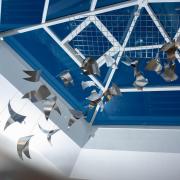Christopher Baker laughs as he recalls the day one of his watercolours was chosen for the Royal Academy’s Summer Exhibition and carried into the gallery. The work was turning heads long before it had even been unwrapped and hung.
‘Watercolours are traditionally small and mine was a nine-foot work and it took eight people to get it in,’ says Christopher. ‘There were all these ladies there who painted watercolours, and some men too, and they were just shocked at this monster.’
A regular exhibitor at the world’s oldest open submission exhibition, the cameo encapsulates both the scale of Christopher’s work and his creative philosophy, which is driven by extremes. The artist, who lives in Arundel, takes en plein air, or painting outdoors, to new levels with his expansive works which have taken him to the wilds of the Arctic, Antarctic and Canadian Rockies as well as seen him paint in the same spot at the Trundle near Goodwood for three months; completing one study every day.

The project was called 64 Days after the time spent on the West Sussex hill from January to March 2012. It also involved Christopher returning each day with his painting materials and outsize equipment to create an unprecedented group of oil paintings, drawings and monotypes measuring up to eight foot in diameter.
‘The whole purpose was to spend longer with the idea,’ explains Christopher who went to primary school in Slindon. He moved away from the county before returning at the age of 32 after leaving a career as a full-time teacher to focus on his work. The idea was sparked by painter Tom Thomson from Canada, where Christopher also lived for a time. In 1917 Thomson painted in Ontario’s Algonquin Provincial Park for 62 days and, being competitive, Christopher decided to top it.
‘I chose this space because while I would like to have gone to the Arctic or Antarctic because it is rawer and has much less of a parkland quality to it, this was a convenient space with a softer and much gentler landscape that is very English,’ he says. ‘I see painting as a way of making a connection to something much larger. It reveals the experience of being alive within the landscape, and its forces and spaces.’

Christopher, a tutor at West Dean College, has been awarded scholarships which have enabled him to work in much more extreme climates than Sussex, including the Norwegian Arctic and Antarctica. In 2017 he carried his board-bound sketchbook - weighing 50 pounds and over three-feet long - to capture landscapes on Cummingoya, a remote island in Svalbard located between Norway and the North Pole. Once in situ he had to work quickly before his paints froze.
He smiles as he remembers an observation from eminent art curator, historian and biographer James Hamilton, who has written books on J.M.W. Turner, Constable and Gainsborough. After seeing video of Christopher with his equipment on the trip he wrote: ‘Film on YouTube shows this bulky man labouring under its weight like a dung beetle in a crisis’.
Christopher continues: ‘I think better when I am physically engaged which is ironic as one would think it would be in an armchair with some books. But I think better when I am actually under an iceberg or up a mountain. It’s more vital, the mind and the body are basically in synch so therefore I do these crazy things. I physically need to carry massive things and it somehow makes me forget myself. Travelling is very important to expand and to feed the heart and expand ideas. I went on a trip to the Canadian Arctic when I was living and working in Canada and that kicked it all off.’

In addition to selling work through his website (christopherwbaker.com) and local exhibitions including Pallant House Gallery in Chichester and Petworth’s Moncrieff-Bray Gallery, Christopher’s last major exhibition in 2023 was at London’s Osborne Studio Gallery. It included a trademark Arctic ‘eight-footer’, which again required a small team to manoeuvre it into place. In his preface to the brochure, James Hamilton commented the exhibition was akin to inserting a ‘ship in a bottle into the domestic proportions’ of the gallery.
The exhibition also included more than 50 canvases of the beach at Climping, one of his favourite locations when he’s working in Sussex; where once again he returns to the same spot in all weathers and seasons to record the changing light. Measuring around a foot, they are among Christopher’s smallest works.
‘They are not the pieces I am known for,’ admits Christopher who prefers the ‘physical impact, kinetic energy and scale of the idea’ portrayed in much of his work and admires artists such as American abstract painter Mark Rothko, known for his large compositions.

The practical logistics of his work means Christopher also requires a much bigger studio than most.
‘I built a little studio at bottom of my garden but it’s used as an office now as it’s too small,’ he says. ‘I have to rent a big place just outside Arundel where I can produce work.’
As well providing an inside base painting when he is not working outside, the studio is also big enough to accommodate a couple of printing presses that Christopher also uses to create large prints on paper.
The size of his work, which starts at around £2,000 for smaller paintings, has led to pieces being commissioned and bought by companies to put on show, including National Car Parks at London’s Millbank Tower, The Royal Mint and the No 1 London Bridge building on the banks of the Thames.

‘In my early career I did a lot of corporate work because they liked large work and I have done a few large pieces for private individuals,’ he says. ‘My work is a very quiet process really, people occasionally see work in large shows but it is mainly through word of mouth that people contact me.’
That said, Christopher has been producing striking work from a very early age. When he was at school in the Cotswolds he sold his first painting at the age of around 16 after a piece exhibited in one of the school shows caught the eye of a member of the kitchen staff who asked to buy it.
While not coming from a family of artists or, as he says, bought up in the environment of Sussex landscape painters John Hitchens and his father Ivon, Christopher said his childhood played a formative part in his love of art coupled with nature.

‘There were gardeners and people who like climbing hills and outdoor stuff,’ he says. ‘We were kicked outside because we were a nuisance and told to go and build a camp. My school probably was a defining influence as it was up a hill in the middle of the Cotswolds and it was there the artistic temperament was given the chance to begin to grow. You don’t start off with a paintbrush in your hand and a beret. It is something that starts to define itself slowly and where you begin to feel more complete, you have a place and you feel a way of being that resonates with you.
‘The great thing was that my art teacher was a painter and artist first and a teacher very much second and so I was riding that in the flow that came from him as a mentor.’
Christopher, who went on to study at West Surrey School of Art and Design and Exeter University, is now mentoring art students in a similar way. ‘West Dean College was kind enough to give me a role as a tutor for the odd course when I moved back to Sussex and that has now carried on for 30 years.’
Some 15 years ago Christopher founded his own School of Landscape Painting which organises field trips to Wales, painting weekends and tutorials.
‘When I was in my forties I thought what do I want to do and what do I like to do,’ he explains. ‘So I said I like landscapes, I like to sell my work and I’m very much interested in landscapes, nature and painting and so that’s what I can offer.’

While Christopher admires the romanticism of the county that is now his home and has inspired landscape painters included Constable and J.M.W. Turner, his personal direction takes him out of any bucolic comfort zone.
‘Sussex is benign and beautiful. I paint a bit in Sussex but it’s not where the work or the landscape of my mind or heart is,’ he says. ‘It needs a much more dangerous, extreme place. I need to be confronted about fundamentals and the universal forces of our lives and our relationship to nature and I can’t do that in Sussex. The landscape and locale of Sussex is like a cosy blanket and then there is this other landscape that is more for the terrified than for the comfortable and I find it necessary to work in extreme places where one is more exposed.’
Christopher concludes: ‘I just don’t want to be ordinary.’ Looking at his immense works and the equally mammoth process that goes into them, it’s a word that would never be used in connection with this remarkable artist or his paintings.




























